Learn Tense and Aspect in English
Struggling to choose the right tense in English? Have you tried learning this before? Or DID YOU TRY? HAVE YOU BEEN TRYING??
Well, look no further and sign up here to follow our short course on using English tense aspect combinations accurately!
You will be notified by email as soon as you are registered on our platform. Once you have activated your account, you can take the following course. (You need to be registered on our platform in order to be able to access the exercises!)
Here at Out Of Our Minds headquarters, we have designed a new way of teaching tense in English which we hope will help you! All you have to do is watch these instructional videos and do the corresponding exercises.
1. Introduction and the present simple
Our first video gives you some very useful tips for the use of tense combinations in English and helps you identify what you really should be paying attention to when choosing a tense combination. Then, we provide a description of the uses of the present simple and some clues to use it properly! Ready to start your learning journey? Then start by watching this video!
Note: You will need a pen and paper to do some of the exercises included in the video.
Hint: once the video is over, just click the “go back” button in your browser to come back to this page.
2. The past simple
The past simple is all about certain types of verbs! To find out more about when to use it, and learn all about the cues that are relevant for this tense, watch this video.
After watching the video, please do exercise 1.
3. The perfect
The present perfect and past perfect rely on different cues than the simple tenses. If you want to better understand in which contexts the perfect form is used, and which elements to look our for, start by watching this short video.
Then, you can do exercise 2 to test your understanding of the present perfect.
Finally, watch this video to find out more about the other type of cues that are relevant for the perfect and to find out more about the difference between present perfect and past perfect.
4. The progressive
The progressive forms can be tricky, especially when you don't have a corresponding form in your own language, but fear not, we have some great tips for you in this video! Here, we explain which elements to look our for and how the progressive differs from the simple form.
5. The future simple
Finally, we pay attention to the future simple. The future simple in English is unusual as it is formed with the auxiliary 'will', but we have some good tips for when to use it! To find out more, watch this video.
After watching the video, test your knowledge with exercise 3.
